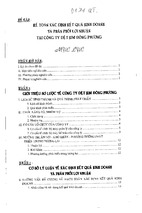Leadership at Toyota…page 78
How to Stop Suite Crime…page 70
www.hbr.org
May 2004
58 Coaching the Alpha Male
Kate Ludeman and Eddie Erlandson
70 The HBR Interview
Eliot Spitzer: How to Restore
the Fiduciary Relationship
Louise O’Brien
78 Learning to Lead at Toyota
Steven J. Spear
92 The Risky Business of Hiring Stars
Boris Groysberg, Ashish Nanda, and Nitin Nohria
102 Building Better Boards
David A. Nadler
18 Forethought
Tame
the
Beast
…page 58
33 HBR Case Study
Oil and Wasser
Byron Reimus
49 Different Voice
Passion for Detail:
A Conversation with Thoroughbred Trainer
D. Wayne Lukas
122 First Person
Telling Tales
Stephen Denning
131 Best Practice
Can Absence Make a Team Grow Stronger?
Ann Majchrzak et al.
148 Executive Summaries
155 Panel Discussion
If you still think of Pitney Bowes as the postage-meter people, here's a thought:
Today, we're working with nearly every FORTUNE 500 company, engineering solutions
that go far beyond the mailroom.
By optimizing the flow of documents, mail and data that stream into and out of
your organization, we can transform it into a powerful tool for advancing business.
The results can be extraordinary: From more-profitable customer relationships to
improved cash flow; a safer, more-secure operation to 24/7 backup in case of disaster.
The list is virtually endless. But, then, so are our ideas.
Hopefully, we're piqued your curiosity. But we can assure you that it will be fully
rewarded with a visit to pb.com/solutions. Or, if you prefer, a call to 1 866 DOC FLOW.
©2004 Pitney Bowes Inc. All Rights Reserved.
HBR
58
Features
102
May 2004
58 Coaching the Alpha Male
70
Kate Ludeman and Eddie Erlandson
Some seven out of ten top executives are alpha males.
And no wonder – highly intelligent, confident, and
successful, alphas are natural leaders who thrive
on levels of responsibility most people would find
overwhelming. But those very strengths can also
drive their coworkers crazy. That’s why alphas, and
the teams that depend on them, need coaching to
make the most of their leadership strengths.
70 How to Restore the Fiduciary Relationship:
An Interview with Eliot Spitzer
Louise O’Brien
“One jail term is worth a lot of compliance officers,”
says New York State attorney general and corporate
reformer Eliot Spitzer, who was behind the $1.4 billion
global settlement between regulators and banking
houses in 2003. What’s really needed, Spitzer suggests,
is for all businesses–and not just securities firms – to
recognize their fiduciary duty to customers and shareholders.
78 Learning to Lead at Toyota
Steven J. Spear
Despite countless attempts to copy Toyota’s famous production system, few companies have been able to match
the carmaker’s performance. In part, that’s because a
special kind of training is needed. Here’s how Toyota
brought one fast-track management recruit up to scratch.
92 The Risky Business of Hiring Stars
Boris Groysberg, Ashish Nanda, and Nitin Nohria
Before you start your next campaign to lure away a competitor’s star, be warned: She’ll never glow as brightly for
you. An extensive and penetrating study shows why it’s
better to create your own stars than to hire someone else’s.
102 Building Better Boards
David A. Nadler
Governance reform isn’t just about cleaning house. An
ambitious board-building process – one that marshals the
right people, agendas, information, and culture – can turn
a good board into a great one.
continued on page 8
COVER ART: DANIEL ADEL
78
92
6
harvard business review
Continental Airlines flies 24/7. They asked Xerox to plot a
course to create and track maintenance advisories digitally.
Result? Paper’s eliminated. Uptime’s sky high.
There’s a new way to look at it.
Learn more: www.xerox.com/learn Or call: 1- 800 - ASK- XEROX ext. LEARN
© 2004 XEROX CORPORATION. All rights reserved. XEROX,® The Document Company® and There’s a new way to look at it are trademarks of XEROX CORPORATION.
HBR
D e pa r t m e n t s
May 2004
10
88
FROM THE EDITOR
S T R AT E G I C H U M O R
Alpha Bets
Whether they’re alpha-male CEOs or
hotshot stock analysts, corporate stars
tend to forget that their success derives
from the talents of their teams and the
cultures of their workplaces. They underestimate the contribution of the many
to the success of a few.
20
122
Telling Tales
Stephen Denning
Leaders who spin an effective yarn have
the power to persuade and, ultimately,
to effect change. So what separates the
winners from the windbags? Knowing
what type of story to tell in a particular
situation.
FORETHOUGHT
18
19
20
21
26
30
Management Lessons from Mars
Found In Translation
Whining Away the Hours
Audit Committees Can’t Add
Stock-Outs Cause Walkouts
Books in Brief
33
HBR CASE STUDY
33
131
Ann Majchrzak, Arvind Malhotra,
Jeffrey Stamps, and Jessica Lipnack
The short answer is yes – far-flung
teams can be even more productive
than those that work face-to-face, if
they’re managed correctly. An extensive
benchmarking study of the most
successful virtual teams reveals how
they turn distance and diversity into
competitive advantage.
Byron Reimus
49
BEST PRACTICE
Can Absence Make
a Team Grow Stronger?
Oil and Wasser
Is it the British–German culture clash
that’s tearing apart this international
merger of cookie makers? Maybe the
real problem is that the “merger of
equals” is just a takeover in disguise.
Or that the two firms’ executives are
scared to death of becoming irrelevant
in the brave new merged world.
FIRST PERSON
49
144
LETTERS TO THE EDITOR
By exercising the three levers of IT –
IT resource management, IT work
management, and IT demand management – companies can not only understand, but systematically maximize,
IT’s contribution to the business.
DIFFERENT VOICE
Passion for Detail:
A Conversation with Thoroughbred
Trainer D. Wayne Lukas
122
What wisdom can a horse trainer offer
to a corporate manager? How to spot
talent early and develop it into worldclass form, despite the fact that the
talent – equine or human – can be headstrong, sensitive, or, yes, even lazy.
148
EXECUTIVE SUMMARIES
155
PA N E L D I S C U S S I O N
They Can Take It with Them
Don Moyer
When knowledge assets sail out the
door with employees, companies soon
miss what they didn’t know they had.
131
8
harvard business review
FROM THE EDITOR
F
ew sights are grander than
a boss who is in touch with his
inner primate. The alpha male is a
tremendous force for good in human affairs. His charisma rallies the
troops once more unto the breach.
His unflagging drive inspires others
to heights they could never scale
alone. His sheer authority causes rivals to put aside their differences
and join in the cause he defines. His
acts of kindness or attention – sometimes the smallest word–can forever
change the lives of the people on
whom he bestows them. Where would business be without him, without J.P. Morgan, Lorenzo de’ Medici, Jacob
Fugger, Alfred P. Sloan, or Sandy Weill?
Yet few sights are more terrifying than an alpha male
on a rampage. The traits that make him glorious make
him dangerous when he’s out of control. His charisma becomes demagoguery; his drive, browbeating; his authority, pigheadedness; his attentiveness, smothering. It’s the
story of Henry Ford’s awful last years, the story told in far
too many courtrooms recently, and the story of every employee ever led by a tinhorn fool. Worse, the alpha male’s
defining characteristic – his unshakable self-confidence –
can keep him from recognizing his problems. If something’s wrong, it must be you.
Where does a 600-pound gorilla sit? Anywhere he
wants, the joke goes. But if he sits in the corner office, he’d
better know his own strength. Kate Ludeman and Eddie
Erlandson are executive coaches who have long experience dealing with alpha males. It’s the most challenging
task in their field. Alphas resist change, not least because
they have been successful in the past. At the same time,
because these leaders have so much power to do good or
ill, successful coaching is a boon for their colleagues and
companies. “Coaching the Alpha Male” is a fascinating
look inside the process. It’s also a practical guide – not just
for coaches but for alphas themselves and the men and
women around them – to the ways in which the natural
leader’s personal power can be put to its best use.
One mistake alphas make is failing to recognize how
much of their success derives from the talents of their
10
teams and the culture of the place
where they work. They’re not alone
in underestimating the contribution of the many to the success of
a few. In “The Risky Business of Hiring Stars,” Harvard Business School
professors Boris Groysberg, Ashish
Nanda, and Nitin Nohria document
how rare it is for star performers to
shine as brightly after they move
from one company to another. It
turns out that a lot of their achievement is based on firm-specific human capital – individual skills that
are more valuable in one context than in others. Moreover,
much of a star’s brightness is really the reflected light of
her colleagues. Take her out of her constellation and she
turns out to be only faintly like what she appeared to be.
Recent articles in HBR have pointed out that roughly
three out of four acquisitions do not pay off for buyers
and that companies’ adjacency moves fail at about the
same rate. Now it appears that personnel moves are dicey,
too. Of course, many acquisitions, adjacency moves, and
new hires work out brilliantly. That happens most often
when managers are rigorous about analyzing the talent
they acquire, the markets where they compete, and the
strategies and tactics they pursue. A true master of these
skills is Thoroughbred racehorse trainer D. Wayne Lukas –
the all-time winningest trainer in America’s Triple Crown
classics, the Kentucky Derby and the Preakness and Belmont stakes. When it comes to acquiring, developing, and
coaching headstrong performers, no one does better. In
senior editor Julia Kirby’s conversation with Lukas, you’ll
find that his advice about managing equine talent resonates strongly for people who manage people, too.
Thomas A. Stewart
harvard business review
ROBERT MEGANCK
Alpha Bets
n
io ,
at ide
c
u w
Ed rld 3
e
o
iv W 00
ut er –2
c
0
e id 0
Ex r ov 20
P
editor
Thomas A. Stewart
deputy editor
Karen Dillon
1
#
executive editor
Sarah Cliffe
art director
Karen Player
Learning that
Powers Performance®
senior editors
Leigh Buchanan
David Champion
Diane L. Coutu
Bronwyn Fryer
Ben Gerson
Paul Hemp
Julia Kirby
Gardiner Morse
Ellen Peebles
Anand P. Raman
associate
editor
Eileen Roche
consulting
editor
Louise O’Brien
Columbia Executive Education
We set the global
standard for success—for individuals and organizations.
Cutting-edge program designs and an active learning approach create
a
results-oriented environment
unmatched in the world. Our
commitment to our clients’ needs has helped us to achieve the
in executive education for
#1 ranking
four consecutive years
( Financial
Times, 2000–2003). We give you the ideas and tools you need to
power your performance.
senior
production
manager
Dana Lissy
associate
production
manager
Christine Wilder
senior designers
Aimee Bida
Jill Manca
production
coordinator
Josette AkreshGonzales
design consultant
Carolann Stutzman
Adams
manuscript
design/production
editors
coordinator
Christina Bortz
Heather
Barrett
Lisa Burrell
Roberta A. Fusaro
communications
manager
Margaret K. Hanshaw
Cathy Olofson
Andrew O’Connell
Andrea Ovans
editorial
coordinators
editor for
Kassandra Duane
business
development
Andrew Gray
John T. Landry
contributing
staff
executive editor
and director
Amy L. Halliday
of derivative
Amy N. Monaghan
products
Annie Noonan
Jane Heifetz
Suki Sporer
editor-at-large,
harvard business school publishing
Walter Kiechel
a note to readers
UPCOMING COURSES
Negotiation and Decision-Making
Strategies [May 11–13]
Fundamentals of Management:
Highlights of an MBA [June 13–25]
Competitive Strategy for Business
Markets [May 23–28]
Finance and Accounting for the
Nonfinancial Executive [June 21–25]
Creating Breakthrough Strategy
[June 6–11]
The Columbia Senior Executive
Program [June 27–July 23]
High Impact Leadership (Formerly
known as Leading and Managing
People) [June 6–11]
Executing Breakthrough Strategy
[August 1– 6]
The views expressed in articles are
the authors’ and not necessarily those of
Harvard Business Review, Harvard Business
School, or Harvard University. Authors may
have consulting or other business relationships
with the companies they discuss.
submissions
We encourage prospective authors
to follow HBR’s “Guidelines for Authors”
before submitting manuscripts. To obtain a
copy, please go to our Web site at www.hbr.org;
write to The Editor, Harvard Business Review,
60 Harvard Way, Boston, MA 02163; or send
e-mail to
[email protected].
Unsolicited manuscripts will be returned
only if accompanied by a self-addressed
stamped envelope.
editorial offices
W W W. G S B . C O L U M B I A . E D U / E X E C E D
800-692-3932 | 212-854-3395
60 Harvard Way, Boston, MA 02163
617-783-7410; fax: 617-783-7493
www.harvardbusinessonline.org
Volume 82, Number 5
May 2004
Printed in the U.S.A.
publisher
Cathryn Cronin Cranston
circulation
fulfillment
manager
Heather McCormick
business
director
Edward D. Crowley
direct marketing
manager
Bruce W. Rhodes
manager,
marketing and
operations
Marisa Maurer
senior business
analyst
Adrienne M. Spelker
advertising
production
manager
Catharine-Mary
Donovan
assistant
subscriber
services manager
Elizabeth Sottile
assistant
advertising
manager
Ashley C. Hartmann
worldwide advertising offices
2004
MBA/Executive
Education
Directory
A SPECIAL
ADVERTISING
SECTION
COMING IN THE
JULY/AUGUST 2004
TOP-LINE GROWTH
SPECIAL ISSUE
SPACE CLOSES
MAY 20TH!
To advertise, call
212-872-9280
Graduate business education
has become more and more
of a necessity for those who
want to advance their careers.
Whether you are considering
education for yourself or
your employees, the 2004
Harvard Business Review
MBA/Executive Education
Directory will be a valuable
tool for identifying and contacting the right institutions.
It’s also an excellent opportunity for providers of business
education to reach a targeted
and motivated audience.
advertising director – worldwide
Trish Henry
212-872-9283
New York Maria A. Beacom
Michael J. Carroll
James H. Patten
509 Madison Ave.
15th Floor
New York, NY 10022
212-872-9280;
fax: 212-838-9659
Atlanta
Boston
Chicago
Dallas
Detroit
Los Angeles
San Francisco
Australia
Beijing
France
Hong Kong
India
Japan
Korea
Malaysia
Singapore
Sweden
Taiwan
United Kingdom
404-256-3800
978-287-5400
312-575-1100
214-521-6116
248-524-9000
310-207-4399
415-986-7762
612-9954-3288
86-10-6401-9190
33-01-4643-1630
852-2516-1001
912-2204-8890
81-3-3479-6131
82-2-3702-1790
603-7729-6923
65-6-836-2272
46-8-541-318-37
886-2-2364-9108
44-20-7586-2224
For advertising contact information,
please visit our Web site at
www.hbradsales.com.
subscription service information
u.s. and canada
800-274-3214; fax: 902-563-4807
Rates per year: U.S., $118; Canada, u.s.$128
international
44-1858-438868; fax: 44-1858-468969
Rates per year: u.s.$165; Mexico, u.s.$128
subscribe online
www.hbr.org
reproduction
Copyright © 2004 Harvard Business School
Publishing Corporation. All rights reserved.
No part of this publication may be reproduced
or transmitted in any form or by any means,
electronic or mechanical, including photocopy,
recording, or any information storage and
retrieval system, without written permission.
general
management
INSPIRING
LEADERS
Organisations need inspiring business leaders who can motivate their teams
to achieve ever-higher levels of performance. London Business School’s general
management programmes are designed for ambitious individuals who want to
become not just better managers, but great business leaders.
London Business School’s Vision is to
be the pre-eminent global business school.
We provide talented individuals with the
global business capabilities required for
successful international careers.
Our three-tiered approach offers vital support at significant career transition points:
We recognise the importance of aligning the personal development needs of
the individual with the objectives of their organisation. We work closely with
sponsoring companies to ensure participants’ learning is directly applicable to
their area of responsibility.
Senior Executive Programme: enables senior managers to create the future
for their organisation.
Accelerated Development Programme: facilitates the transition of senior
functional managers into business leaders by developing core capabilities that will
equip them to be highly effective general managers.
Young Professionals Programme: progresses the development of emerging
leaders, from high potential to high performing employees.
Senior Executive
Programme
Accelerated
Development
Programme
Young Professionals
Programme
Available as a 4 week residential programme.
• 12 September – 8 October 2004
Available as both a 4 week and 2 x 2 week (modular)
residential programme, supported by virtual learning
technology throughout an 8 month period.
Four-week programmes:
• 20 June – 16 July 2004
• 31 October – 26 November 2004
2x two-week programme:
• 10 – 22 Oct and 28 Nov – 10 Dec 2004 (modular)
Available as a 2 + 1 week residential programme,
supported by virtual learning technology throughout
an 11 week period.
• 29 Aug – 10 Sept and 24 – 29 Oct 2004
Executive Education
w w w. l o n d o n . e d u / e x e c e d / h b r /
For further information please contact (quoting reference EE0309)
Andrew Wilson, Client Services, Executive Education,
London Business School, Regent's Park, London, NW1 4SA
Tel +44 (0)20 7706 6836 Fax +44 (0)20 7724 6051 Email
[email protected]
We’re providing more natural gas
so that millions more can be comfortable.
Working with our partners around the world, we’re developing new ways to bring you more natural gas.
Enough to power over 6 million more homes every day. Because, while demand for this cleaner energy is
rising dramatically, so is our ability to meet it.
Turning partnership into energy.™
©2004 ChevronTexaco Corporation. ChevronTexaco is a trademark of ChevronTexaco Corporation.
F o r e t h o u g h t
research
Management Lessons from Mars
Go ahead and raise the bar. Just don’t make the same mistakes NASA did.
by Alan MacCormack
There is no reason
to believe that
success indicates
a flawless process
while failure is the
result of egregious
bad practice.
18
In January, two small spacecraft bounced onto
the surface of Mars, delivering rovers that have
captivated the world with their stunning photographs of the Martian landscape. By contrast,
four years earlier NASA had watched in horror
as two successive Mars missions blinked out of
existence within a three-month span. Much of
the blame for those failures was placed on the
agency’s Faster, Better, Cheaper (FBC) initiative,
a program established in the early 1990s and
designed to transform the way NASA developed
unmanned spacecraft. The goal was to drastically reduce project costs while speeding development times. Development was indeed faster,
and missions were indeed cheaper – but the approach was flawed, as the doomed 1999 missions
suggest. As I talked with NASA managers about
the FBC program, I discovered an overarching
organizational problem – a learning disability,
if you will – that holds lessons for managers in
many other environments.
In shifting to FBC from a slow, reliable, but
costly approach to development, NASA forced
its project managers to invent radically new processes and procedures. FBC imposed on them
budget, schedule, and weight constraints that
could not be met using NASA’s traditional approaches to spacecraft development. “The attitude was ‘The book’s not working. So throw out
the book, try something different, and then write
a new book,’” one NASA manager explained. Implicit in this approach was the need for project
managers to learn from the organization’s collective experiences, adopt what worked, and
jettison what didn’t. Unfortunately, NASA undermined this learning process in several ways.
First, with the launch of each FBC mission,
NASA demanded ever faster development times
and even lower costs. But because it typically
takes more than four years for a small spacecraft
to go from drawing board to completed mission,
managers were forced to meet the tougher demands on new projects while earlier projects
were still in progress. So they couldn’t capture
all the potential lessons from one mission before moving to the next. In short, NASA was raising the bar before seeing if project managers
could clear it where it was. By the time the organization realized it had set the bar too high –
around the time the first FBC missions began
to fail – the project pipeline was full of missions
that were potentially compromised. It’s no surprise that later FBC missions failed more frequently than earlier ones did.
Second, NASA didn’t realize that because the
FBC initiative depended so much on shared
learning, it would require a more aggressive
and systematic approach to knowledge management. Although NASA had implemented a
“lessons learned” database in 1995, a 2001 survey found that only one-quarter of its managers
contributed to it. A similar number of managers were unaware the system even existed. Furthermore, while “red team reviews” – periodic
progress reviews conducted by NASA’s most
experienced managers – proved invaluable in
early FBC projects, NASA conducted fewer of
these assessments in later missions. As a consequence, the transfer of learning across the organization suffered.
Finally, NASA fell prey to “superstitious learning” – the assumption that there is more to be
gleaned from failed missions than from successful ones. In the challenging climate of space
exploration, however, the difference between
what makes one mission succeed and another
fail can be subtle. There is no reason to believe
that success indicates a flawless process while
failure is the result of egregious bad practice.
For example, as many mistakes could have been
harvard business review




















